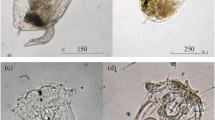Abstract
The periphytic and colonial Rotifer Sinantherina socialis is a thermophile species living between 18 and 34°C. The hatching of its eggs takes place daily with a rhythm linked to the photoperiod. The sexual cycle is characterized by the existence of amphoteric females producing two kinds of eggs. The occurence of mictic eggs appeared to be significantly related to short photoperiods and great densities of population.
Resume
Le Rotifère épiphyte et colonial Sinantherina socialis (Linné) prolifère dans la Loire depuis quelques années. Ses caractéristiques biologiques et écologiques ont été étu-diées au laboratoire et sur le terrain.
Malgré une répartition des pontes régulière dans le temps, les éclosions manifestent une rythmicité liée a la photopériode. La determination des durées de dévelop-pement embryonnaire et post-embryonnaire, du rythme de ponte, de la dúree de la période de sénilité et de la durée de vie à différentes températures montrent que cette espèce se développe entre 18 et 34°C, avec un optimum à 27°C.
Le cycle sexué se caractérise par l'existence de femelle ‘amphoteres’, capables d'émettre des oeufs femelles, apparemment amictiques, après avoir produit des oeufs mâles. L'apparition de la micticité est Re aux photopériodes courtes et aux fortes densités de population. Des températures suffisamment élevées (plus de 18°C) ont permis d'obtenir au laboratoire jusqu'à 80% d'éclosions parmi les oeufs de duree.
Summary
The periphytic and colonial Rotifer Sinantherina socialis has been swarming in the river Loire every summer for some years. Its biological and ecological characteristics have been studied in the laboratory and in the field.
Although the eggs are laid regularly in time, the hatching occurs daily with a rhythm linked to the photoperiod. It occurs about 10 hours after the beginning of the light-period with a 16–8 (LD) photoperiod, 11 hours with a 14–10 photoperiod and 12 hours with a 12–12 photoperiod. To explain this hatching synchronisation and shift in time, the existence of a substance synthesized in the egg by night and destroyed by light might be assumed. The mature eggs would be sensitive to this substance, which would have the effect of delaying the hatching.
Measurements of the duration of embryonic and post-embryonic development, of the frequency of laying eggs, of the duration of the senility period and of the duration of life, show that this species can grow between 18 and 34°C, the optimum being 27°C.
The sexual cycle is characterized by the existence of ‘amphoteric’ females, capable to emit apparently amictic eggs, after having produced male eggs. The occurrence of mictic reproduction appeared to be significantly related to short photoperiods and great densities of population. Sufficiently high temperatures (more than 18°C) allowed 80 per cent of hatching among the resting eggs in laboratory cultures.
Similar content being viewed by others
Bibliographie
Amren, H. 1964. Ecological studies of zooplankton populations in some ponds on Spitsbergen. Zool. Bid. Uppsala 36: 161–191.
Beauchamp (De), P. 1965. Classe des Rotiféres. In Grassé, P. P., Traité de Zoologie, t. IV, fasc. III. Masson et Cie, Paris. p. 1299–1305 et p. 1314.
Birky, C. W. Jr. & Gilbert, J. J. 1971. Parthenogenesis in Rotifers: the Control of Sexual and Asexual Reproduction. Am. Zool. 11: 245–266.
Bogoslovsky, A. S. 1958. New data on the reproduction of heterogonous Rotifers. Observations on the reproduction of Sinantherina socialis. Zool. Zh. 37 (2): 1616–1623 (en russe).
Bogoslovsky, A. S. 1960. Observations on the reproduction of Conochiloides coenobasis and the statement of a physiological category of females new to heterogonous Rotifera. Zool. Zh. 39 (5): 670–677 (en russe).
Buchner, H. 1971. Die Sexualität der heterogonen Rädertiere. Naturwiss. Rdsch. 24: 191–199.
Champ, P. 1974. Etude des pullulations de Rotifères périphytiques dans la Loire à l'aide de supports artificiels. Bull. Fr. Pisc. 252: 119–123.
Champ, P. 1976. Etude des populations d'un Rotifére épiphyte dans la Loire. Thèse 3e cycle. Univ. Paris VI. 81 pp, 3 pl. h.t.
Champ, P. sous presse. Dynamique d'une population d'un Rotifére épiphyte thermophile (Sinantherina socialis) en présence de pollution thermique. Arch. Hydrobiol.
Edmondson, W. T. 1960. Reproductive rates of Rotifers in natural populations. Mem. Ist. Ital. Idrobiol. 12: 21–72.
Edmondson, W. T. 1965. Reproductive rate of Planktonic Rotifers as related to food and temperature in nature. Ecol. Monogr. 35: 61–111.
Gilbert, J. J. 1974. Dormancy in Rotifers. Trans. Amer. Micros. Soc. 93 (4): 490–513.
Pourriot, R. 1963. Influence du rythme nycthéméral sur le cycle sexuel de quelques Rotifères. C.R. Acad. Sci. Paris 256: 5216–5219.
Pourriot, R. & Clément, P. 1975. Influence de la durée de l'éclai-rement quotidien sur le taux de femelles mictiques chez Notommata copeus Ehr. (Rotifére). Oecologia 22: 67–77.
Pourriot, R. & Deluzarches, M. 1971. Recherches sur la biologie des Rotifères. III — Influence de la température sur la durée de développement embryonnaire et post-embryonnaire. Ann. Limnol. 7 (1): 25–52.
Pourriot, R., Rouyer, G. & Peltier, M. 1972. Prolifération de Rotifères épiphytes et pollution thermique dans la Loire. Bull. Fr. Pisc. 244: 111–118.
Surface, F. M. 1906. The formation of new colonies of the Rotifer Megalotrocha alboflavicans. Biol. Bull. 11: 182–192.
Winberg, G. G. 1971. Methods for the estimation of production of aquatic animals. Academic Press, London & New york, XI + 175 pp.
Author information
Authors and Affiliations
Rights and permissions
About this article
Cite this article
Champ, P., Pourriot, R. Particularites biologiques et ecologiques du Rotifere Sinantherina socialis (Linne). Hydrobiologia 55, 55–63 (1977). https://doi.org/10.1007/BF00034805
Received:
Issue Date:
DOI: https://doi.org/10.1007/BF00034805




